| With
a men’s program reaching 120 years in 2023, and a women’s program with 50
years of modern history (and another ten in early history), a timeline of
highlights is subjective at best. So please read this summary knowing these
are selections of a much broader and far more important historical picture.
When the original history was published in
2003 for the UW Rowing Centennial, it was written as a continuing story,
each year different but each year consistent and built on the same
foundation created by Hiram Conibear
and the men and women of those earliest years. Our goal has been to
continue the theme that Washington Rowing is unique in many ways, but
particularly in the consistent values that drive the program, and these
values continue
today in our coaches and student-athletes that row at Washington.
This timeline does not touch on the
human stories that define the program, and I urge anyone reading this
summary to read the more in depth history. We have one book – The Boys in
the Boat – that covers a small timeframe in the life of the men's program,
and yet every year and generation has similar stories, and students, and
coaches and leaders. And every year could be a book. Some do not end
as successfully on the water as the 1936 men's team, but ask any Washington
alum at their fiftieth reunion and the response will be the same: an
enduring gratitude for what rowing at Washington did for them in their life.
And then finally this: this timeline, as a
summary exercise, leaves years out. And yet every year has had a Washington
Varsity 8 and a 2V8 and other boats, and some of those years end with
National Champions. Some end with Conference champions. Or amazing comeback
stories or stunningly bad luck. After twenty years of learning so many of
these stories, I firmly believe that if we could line up
every Varsity 8 at their prime since our first one in 1907 - and have them race
2,000 meters on one giant race course - the winner could easily not be on
this timeline. Because at
Washington, every Varsity 8 throughout our history has high-level athletes developed
under the same core values; and on any given day in crew racing the "swing"
can come... and then anything can happen.
So take this as the summary exercise it is.
The real story of Washington Rowing, true since the very beginning, is the
opportunity - as George Pocock would say - for young people to reach for the
stars and then go put it all on the line as a team, together.
Note: The National Championship race
distance, the sponsoring organization, and number of events have all changed
multiple times since 1910. Today, for men, a national team champion is
awarded (known as the Ten Eyck Trophy) based on points earned in all IRA
events; however regardless of team results, the winner of the IRA
(Intercollegiate Rowing Association) Varsity 8 race is considered the
Men's Collegiate National Champion. That was also true for the women’s National
Championships
through 1996; however in 1997, when the NCAA began governing the women’s
sport, the officially recognized National Champion became the combined team
(V8, 2V8, V4) with the highest point total (cumulative points awarded based
on race finish in each event), and not the Varsity 8 race.
A note to our readers: The
best viewing experience of this content is by laptop or desktop computer
(or tablet).
Originally published
ten years before social media
and smartphones using Microsoft Frontpage
software, technically upgrading the extensive content and
collections now to meet smartphone formatting (over 600 pages of
historical writing, photos and media) is financially prohibitive.
From the beginning, this project was built for the web: combining the
flexibility to easily update and add new material, with the ability to support
the history with audio and
video. As an example: this timeline was added in August of 2023, over
twenty years since content was first being collected and published here. It continues today as one of only a handful of
extensively detailed and consistently updated (men and women combined) collegiate sports history
collections in the world. The downside to publishing
on the web is the ease to which material can be used without consent.
Please respect the effort and time that our authors, photographers, and
contributors have put into this body of work, and if using any material
published here, please contact us first.
All material
on the Huskycrew.org website, including all writing, photos, video, and audio,
are copyrighted. For questions, comments, or history additions, please contact
Eric Cohen at: webdev (at) huskycrew.org.
|

|
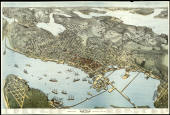 |
|
1895:
The University of Washington moves from downtown Seattle to the new location
between Lake Washington (to the east) and Lake Union (to the west). Rowing
was taking place by 1896, with various official “start” dates, including
1896, 1899 and 1901. The first Class Day race took place in 1901, along with
a “colleges” race (Forestry; vs. Arts and Sciences; vs. Engineering, etc). |
| |
|

|
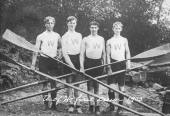 |
|
1903:
Team rows/trains out of Union Bay (Lake Washington) boathouse; first
intercollegiate race and the beginning of varsity rowing at Washington;
racing in 4-oared wide body shells (wherries), the UW races California on
Lake Washington in Seattle and wins. |
|
|

|
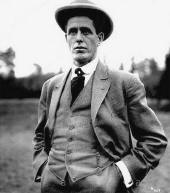 |
|
1907:
Hiram Conibear arrives: Hired by the UW as a trainer for the football and
track teams from the Chicago White Sox, he was asked to fill the vacant
rowing coach role (for which he had no experience); he accepted, and the
sport became his passion. Conibear re-developed the rowing stroke and
permanently changed the sport; he is one of only a handful of coaches that
influenced rowing globally to the degree he did. At Washington, he set the
foundation for the program (Rowing Stewards, Women’s Rowing, Varsity Boat
Club and more) that still exist today. |
| |
|

|
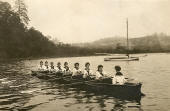
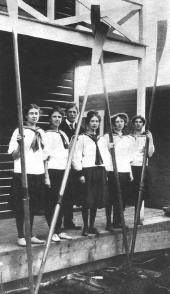 |
|
1907 -1917: Women’s
rowing at Washington: the only public university in the nation with a
consistent women’s rowing program at the time. A thorn in the side of the UW
Administration (who considered rowing “too rigorous” for women), the program
thrived as one of the most popular on campus for female students.
|
|
|

|
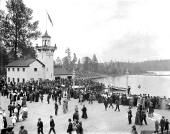
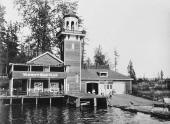 |
|
1909:
The men's team moves into the Alaska Yukon Exposition Coast Guard Exhibit lighthouse building (shown
here during and after
the 1909 fair on campus) on Lake Union; Varsity Boat Club established. |
| |
|

|
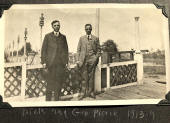 |
|
1912:
Dick and George Pocock, at the behest of Conibear, move from Vancouver BC to
Seattle and set up shop on Portage Bay in the "Tokyo Tea Room", another
former AYE World's Fair building next door to the lighthouse. Photo: thank you Al Mackenzie
|
| |
|

|
 |
|
1913: The first
IRA (Intercollegiate Rowing Association) National Championship competition for Washington at Poughkeepsie, NY;
raising the needed travel funds from the Seattle community, the team
surprises the New York crowd by finishing third, establishing Washington as a legitimate national
contender.
|
| |
|

|
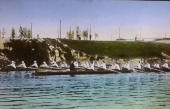 |
|
1915:
First 8-oared shell built for the women’s team by George and Dick Pocock,
named the “1915 Co-ed”. |
| |
|

|

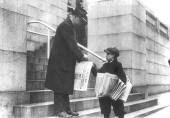 |
|
1917:
Hiram Conibear dies tragically; WWI starts and the campus is depleted of
men; Dick and George Pocock are hired by Boeing and leave the boatbuilding
business; west coast men's rowing is upended and barely
survives, while women’s rowing is cancelled and will not return until the
60's. |
| |
|

|
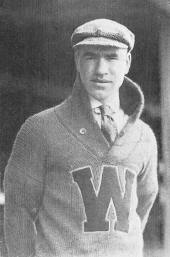
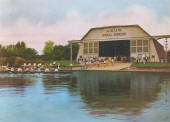 |
|
1919:
Following the end of the war in 1918, Ed
Leader assumes the men's head coaching role and makes a deal with the Navy and
upper campus to move into the vacated Navy Hangar on the new (1917) Montlake
Cut. That hangar-turned-shellhouse is being restored by the UW in the next
three years; a replica will be featured prominently in The Boys in the
Boat movie. |
| |
|

|
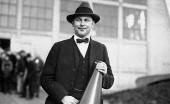
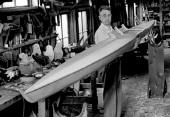 |
|
1922: Ed
Leader leaves for Yale along with Dick Pocock; Rusty Callow (a major influence on Washington
Rowing) becomes head coach; George Pocock is convinced by Callow to leave
Boeing and return to the UW to pursue his passion of building shells (in a
shop loft built for him by Callow at the old hangar, the shop still almost
fully intact today); Pocock said he was
“forsaking the substance and grasping the shadow”. |
| |
|

|
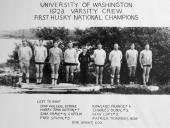 |
|
1923: The
first IRA Varsity 8 National Championship in Washington history and the first west
coast team to win the IRA. |
| |
|

|
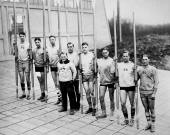 |
|
1924:
Washington repeats as IRA
Varsity 8 National Champions. |
| |
|

|
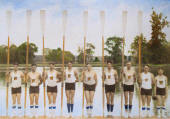 |
|
1926: IRA
Varsity 8 and JV8 National Champions, first two-boat NC at the IRA for
Washington. |
| |
|

|
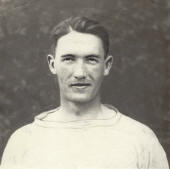 |
|
1928: Rusty
Callow leaves for Penn; the young frosh coach Al Ulbrickson (stroke of the 1924-1926 V8) becoming
head coach at Washington. |
| |
|

|
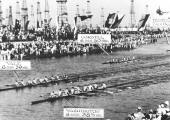 |
|
1933:
Undefeated Varsity 8 wins the first collegiate 2,000m National Championship
at Long Beach, California, over Yale, Cornell, and Harvard. |
| |
|

|
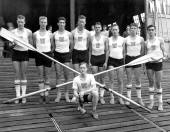
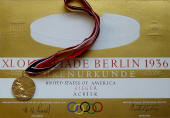 |
|
1936: The first
IRA National Championship sweep (Freshmen, JV, Varsity 8’s all win) by any
university in the history of collegiate rowing... and The Boys in the
Boat become Olympic Champions in the Eight at the 1936 Berlin Olympics. |
| |
|

|
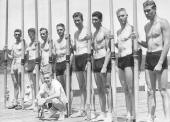 |
|
1937: The Boys
in the Boat return (only coxswain Bob Moch graduated) and come away with
another IRA Sweep and the Varsity 8 National Championship. The 1937
full team remains one of the most dominant in the history of Washington, and
in the sport itself.
|
| |
|

|
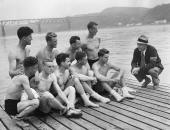 |
|
1940:
Varsity 8 National Champions with Ted Garhart as stroke, Al Ulbrickson
calling him "the best oarsman I have ever coached." |
| |
|
|
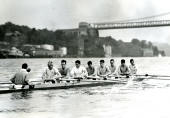
 |
|
1941: An
even more dominant repeat Varsity 8 National Championship, again with
Garhart (the 1941 Seattle Post-Intelligencer "Sportsman of the Year") at
stroke. The '40 and '41 teams are still considered some of the best in
Washington Rowing history, the "swing" a definition of this group of young
men. |
| |
|

|
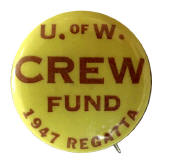
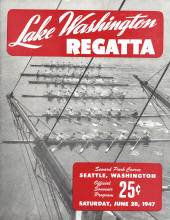 |
|
1946, 1947:
Following the end of WWII, and with the IRA still mothballed in 1946,
Seattle took the opportunity to sponsor a 2,000 meter National Championship
race on Lake Washington by raising the nearly $50,000 needed through a
community fund drive. The regatta was a huge success, the Chamber of
Commerce following it up in 1947 with an even larger regatta, a race with an
estimated 150,000 fans lining the Seward Park course on Lake Washington.
These races remain two of the largest spectator events in the history of the
sport. |
| |
|

|

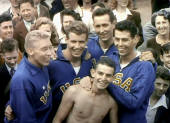 |
|
1948:
Varsity 8 National Champions and another IRA sweep; the stern 4 (the four
oarsman closest to the coxswain in an eight-oared shell) of the JV8 enter
and win
the U.S. Trials as a coxed 4+, qualifying for the London Olympics. The five
young men, coached by George Pocock in a return to his home country of
England, win the Olympic Gold
on the Henley course. |
| |
|

|

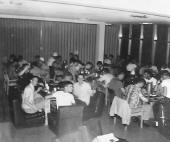 |
|
1949/50:
The men move out of the ASUW Shellhouse in the fall of 1949, and into the new Conibear Shellhouse
at the current location...
...complete with three square meals a day in the spring of 1950. |
| |
|

|
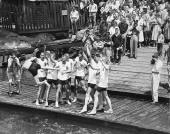 |
|
1950: Men's
Varsity 8 National Champions and another IRA sweep; 4th IRA sweep by the UW;
all other rowing programs combined, zero. |
| |
|

|

 |
|
1952:
Ulbrickson focuses on the coxed 4 with four of his top varsity rowers at the
US Olympic Trials and it pays off: the team wins the National Championship
and goes on to win Olympic bronze at the 1952 Olympic Games in Helsinki,
Finland. |
| |
|

|
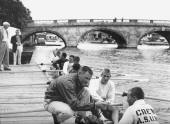
 |
|
1958:
Following a loss to the dominant Soviet Union at Henley, the Huskies travel
behind the Iron Curtain and shock the world two weeks later by defeating
that same Soviet team in Moscow, with ABC's Keith Jackson calling the play
by play in a live broadcast back to the United States. |
|
|

|
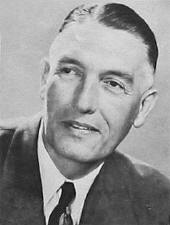
 |
|
1959: Al
Ulbrickson retires; Fil Leanderson (’52 Olympic bronze medalist) becomes
Head Coach. |
| |
|

|
 |
|
1960: The
Seattle community and media - since the days of Hiram Conibear - continue to
embrace the team. |
| |
|

|
 |
|
1964: The
Varsity eight setting a new 2,000 meter Montlake Course record going
sub-6:00 for the first time in program history. The 1964 freshmen, JV and
Varsity combined would win the Ten Eyck Team trophy at the National
Championships for the highest team finish among all competitors. |
| |
|

|
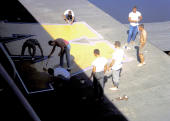 |
|
1965:
Additional housing wing completed at Conibear Shellhouse where the men would
live together under the VBC banner for 30 years; Big W first painted on the dock
apron; men make stunning reversal to sweep the West Coast Championships. |
| |
|

|
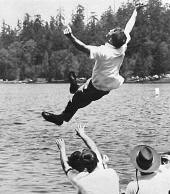
 |
|
1968: Dick
Erickson becomes men’s head coach, and in his first year wins the West Coast
Championship;
the women, under the leadership of undergraduate Joan Bird, form a varsity club team
with IMA Coach Bernie Delke, and row out of the
old ASUW shellhouse. |
| |
|

|
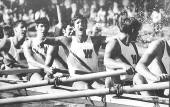
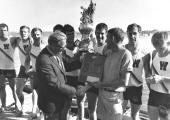
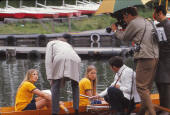
|
|
1970: First
“Opening Day” crew races in conjunction with the Seattle Yacht Club down the
Montlake Cut in May; IRA Varsity 8 National Champions and IRA Team Champions; Men’s
4+ win US Trials and represent USA at the World Championships; Women’s club
team wins the National Championship in the Lightweight 4+, the first
collegiate championship won by the women. |
| |
|

|
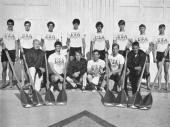 |
|
1971: The
men
win the US Rowing National Championship and the Pan Am Trials in the eight
and travel to Cali, Colombia, where they win the silver medal representing the USA at
the Pan Am Games. |
| |
|

|
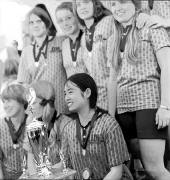 |
|
1972: Title
IX becomes law; UW women’s lightweight 8 and quad win NWRA National
Championships. |
| |
|

|
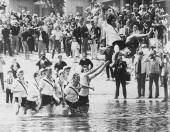 |
|
1973: Dick
Erickson foregoes the IRA (the Varsity would not return to the IRA for over
twenty years) and takes his strong men’s team to Henley, continuing his emphasis on
international competition. |
| |
|

|
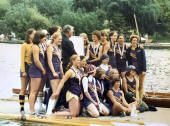
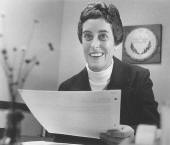 |
|
1975:
Women’s Rowing becomes a varsity sport at Washington under the guidance of
Senior Associate Athletic Director Kit Green; John Lind named the first Varsity Women's head coach. |
| |
|

|
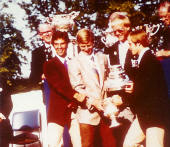
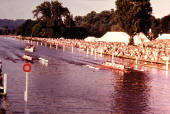 |
|
1977: The
Washington men win historical victories in the Visitors’ Cup and the Grand
Challenge Cup (over the British National Team) at Henley; Varsity 8
consensus National Champions. |
| |
|

|
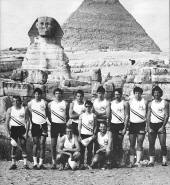 |
|
1978: The Men’s
Varsity 8 are consensus National Champions; First of six trips to Egypt that
Dick Erickson would take his top rowers for the “Festival of Oars” in Cairo,
Egypt. |
| |
|

|


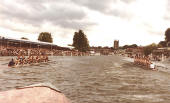
 |
|
1981: Dick Erickson appoints his freshman
coach, Bob Ernst, as women's head coach in the fall of 1980, and the results
are immediate: the team wins the first of five NWRA Collegiate Varsity 8 National Championships in a row (still unprecedented) from
'81-'85; women’s Varsity 8 and 2V8 win National Titles; undefeated men’s
Varsity 8 consensus National Champions; men’s JV8 wins the first Ladies’ Plate
title for the UW at
Henley. |
| |
|

|
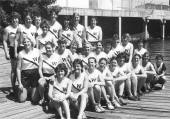 |
|
1982:
Dominant women’s team wins Varsity 8 (top row) and 2V8 (middle row) NWRA Collegiate National
Championships; the freshmen (front row in this photo) also go
undefeated on the season. |
| |
|

|
 |
|
1983: The
Women’s Varsity 8 wins the Collegiate National Championship. |
| |
|

|



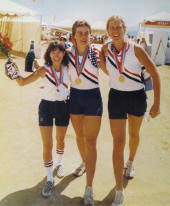 |
|
1984:
Washington wins the Men's Collegiate National Championship Varsity 8; Women’s Varsity 8
wins the Women's Collegiate National Championship; Husky head coach Bob
Ernst coaches the USA Women’s eight to Olympic Gold in LA, including
three UW alums: Betsy Beard, Shyril O'Steen, and Kristi Norelius. |
| |
|

|
 |
|
1985: The
Women’s Varsity 8 wins the Collegiate National Championship for an
unprecedented 5th year in a row. |
| |
|

|

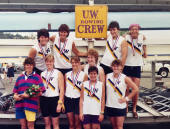 |
|
1987: The
inaugural “Windermere Cup”, featuring the Soviet Union’s top men’s and
women’s teams racing the Huskies in front of a huge crowd lining the
Montlake Cut;
Women’s Varsity 8 returns to the top of the national podium by winning the US Rowing Collegiate National Championship;
and the team sweeps the Collegiate National Championships (V8, 2V8, V4+)
for the first time in history by
any team. |
| |
|

|
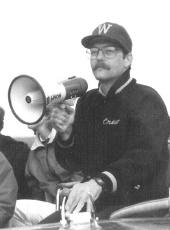
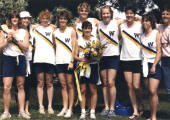
 |
|
1988:
Washington
Women again win the US Rowing Varsity 8 Collegiate National Championship; Bob Ernst replaces Dick
Erickson as men’s head coach; Jan Harville takes the helm of the women. |
| |
|

|
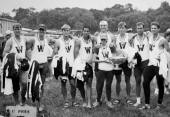 |
|
1993: Bob
Ernst sends his JV 8 to the IRA's (the Varsity National Championship was a
single race in Cincinnati won by Brown), the first Washington team to
compete at the IRA's since 1972, and the team surprises the field to win the
National Championship. This win sat the stage for Washington to
finally return to the IRA, which they did as a full team in 1995. |
| |
|

|
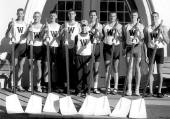

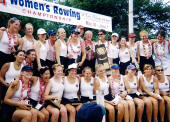 |
|
1997: Men’s
Varsity 8 and Team National Champions and a sweep of the IRA eights for the 5th time;
Women win the inaugural NCAA Varsity 8 race and the NCAA team title – the
first NCAA team title in any sport in Washington Athletics history. |
| |
|

|
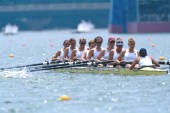
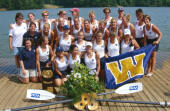 |
|
1998: A
dominant women's Varsity 8 wins the NCAA National
Championship and the women's team repeats as NCAA Team National Champions. |
| |
|

|
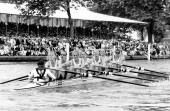
 |
|
2000: The Women
win the inaugural Henley Prize for international
women’s eights (now called the Remenham Cup, the top competition for women
at Henley). |
| |
|

|
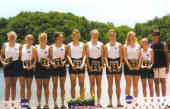
 |
|
2001: The
Washington Women
win the NCAA Team Championship and the Varsity 8 wins the NCAA National Championship.
|
| |
|

|
 |
|
2002: The
Washington Women
win both the Varsity 8 and 2V8 NCAA Championship events. |
| |
|

|
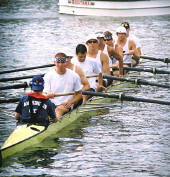
 |
|
2003: The Men’s
Varsity 8 wins the Ladies’ Plate at Henley in the Centennial Year of the
program; Jan Harville retires, Eleanor MacElvaine becomes women’s head coach. |
| |
|

|
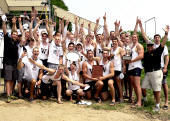
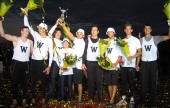 |
|
2007: IRA
Men’s Varsity 8 National Champions and Team Champions, beginning an
unprecedented (by any team in the history of collegiate men's rowing) streak of nine
consecutive
IRA Ten Eyck Team Championships from
2007-2015; Varsity wins the major international event known as the Moscow Race of Champions in Russia over
Cambridge, Oxford and Moscow State University. |
| |
|

|


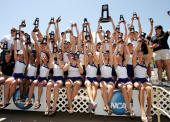
 |
|
2008: IRA
Team National Champions; Bob
Ernst switches back to women’s head coach; Michael Callahan elevated to
men’s head coach; Women win NCAA Varsity Four National Championship and the team
finishes 2nd in the NCAA; Anna Michelson and Mary Whipple win gold in the
USA eight at the 2008 Beijing Olympics. |
| |
|

|



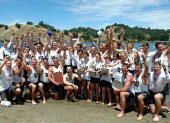 |
|
2009:
Washington Men: IRA
Varsity 8 National Champions in one of the most improbable comebacks in
regatta history; the 6th eights sweep in UW history; Team National
Champions. |
| |
|

|
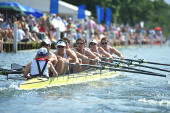 |
|
2010: IRA
Team National Champions, and the
Washington men’s undefeated freshmen win the Temple Cup at Henley. |
| |
|

|

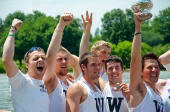
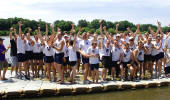 |
|
2011: A
deep and talented men's team win the IRA
Varsity 8 and Team National Championship; 2V8, V4+, O4+ also gold. |
| |
|

|

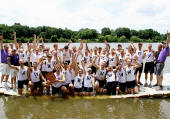

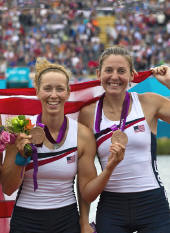 |
|
2012:
Washington Men's undefeated Varsity 8 National Champions cap the first
five-event sweep in the history of the IRA: O4+, V4+, F8, 2V8, V8 all gold;
7th eights sweep in UW history; V8 row a 5:21 in the IRA Grand Final, the
fastest time in IRA and UW history and two seconds off the World Record;
seven former Huskies
medal at the 2012 London Olympics (men and women combined, pictured are
Megan Kalmoe '06 and Adrienne Martelli '10 with bronze in the USA Quad); and the Washington
Men's Freshmen win the Temple Cup at
Henley. 2012 marks the most dominant full-team performance in the history of
men's collegiate rowing. |
| |
|

|

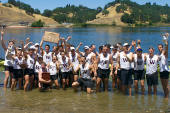
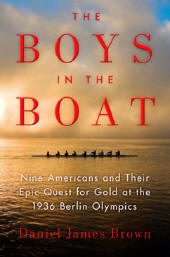 |
|
2013: IRA
Varsity 8 and Team National Champions and the second five-event sweep in the history
of the IRA: O4+, V4+, F8, 2V8, V8 all gold; 8th eights sweep in UW history.
Daniel James Brown's The Boys in the Boat, the story of Joe
Rantz and the 1936 Washington rowing team, debuts and becomes a national and
international Best Seller. |
| |
|

|

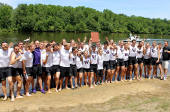
 |
|
2014: Men
are IRA Varsity 8 and Team National Champions for the 4th year in a row; Women’s Varsity 8 are invited to the
Gallagher Great Race on the Waikato River in New Zealand, a winding, highly
strategic river course, and win in an
upset victory over New Zealand's Waikato University. |
| |
|

|

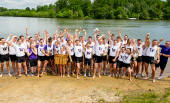
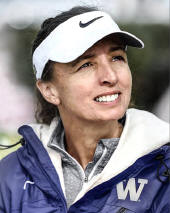 |
|
2015: Men
make IRA
history with 5th consecutive Varsity 8 National Championship, and the third five-event sweep in the history
of the IRA to win another perfect Team Championship: O4+, V4+, F8, 2V8, V8 all gold; 9th eights sweep in UW history;
UW V4+
wins Prince Albert Cup at Henley; Yaz Farooq replaces Bob Ernst as Women’s
head coach. |
| |
|

|

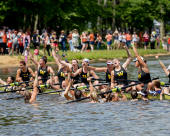

 |
|
2017: The
Washington women with a historical sweep - and perfect National Team Championship
- at the NCAA's (V4, 2V8, V8
all gold), unprecedented in the history of NCAA Rowing. |
| |
|

|


 |
|
2018: The
Washington Men and Women dominate the Pac-12 Championships winning 9 of 10
races combined and sweeping the team titles; Women win
the NCAA 2V8 National Championship and team finishes 2nd in the NCAA; UW men win
the Temple Cup at Henley.
|
| |
|

|
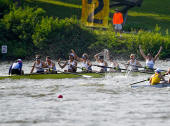
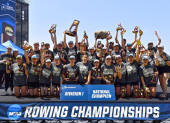 |
|
2019: The
Women's Varsity Eight with a comeback win for the ages at the NCAA's:
trailing in 6th place late in the Grand Final, coxswain Marley Avritt asks
her team to re-commit to each other. "It was sheer human will," said head
coach Yasmin Farooq of the response to Avritt's request, as the team blew
past the five other teams in the last 500m to win with an NCAA record time
in what will remain one of the most legendary comebacks in Washington
history. "At every championship we always talk about our teamwork within
each boat and across all boats," Continued Farooq. "We talked about it
last night before the finals, about not only pulling for the people in their
boat and the people that are here but for all the incredible people back
home supporting us this entire year."
The win solidified the Team Championship and completed the repeat of the
2017 V8/2V8/V4 Sweep at the NCAA’s;
the UW women are the only team to sweep the Women’s National Collegiate Championships and they
have done it three times: 1987 (USRA); 2017 (NCAA); and 2019 (NCAA). |
| |
|

|
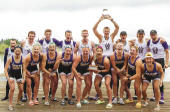


|
|
2021: Men
and Women V8's sweep the UW/Cal Dual Race; The
Washington men are IRA
Varsity 8 National Champions with a four-event sweep and Team Title; V4+, 3V8, 2V8, V8 all gold; 10th eights sweep in UW
history; Women win the NCAA V4+ and 2V8 events; finish 3rd in NCAA team standings. |
| |
|

|
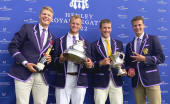 |
|
2022: UW
men win the Visitors’ Cup at Henley for the first time since 1977. |
| |


![]()
![]()